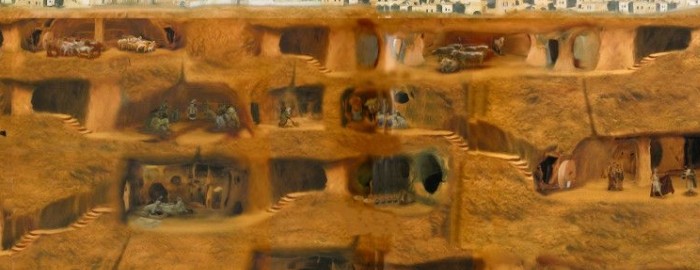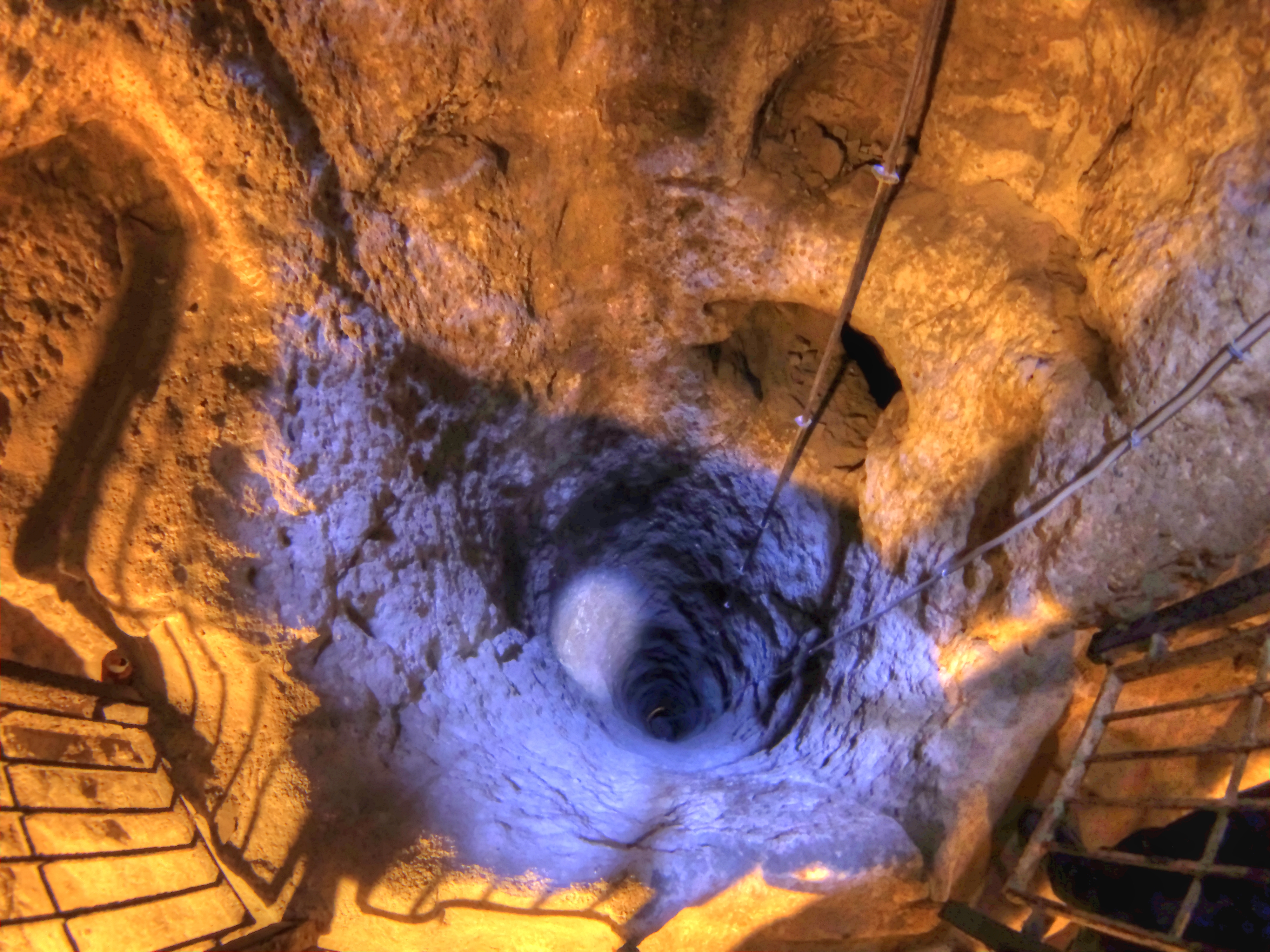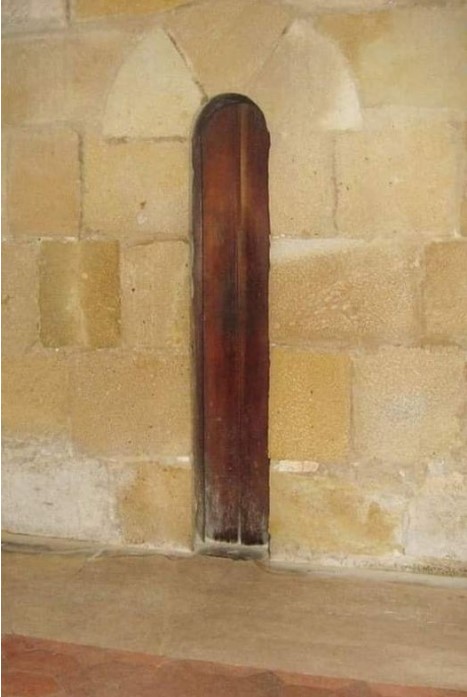New Ebrelia
Off the coast of Mahut on the southern coast of The Ember Isles /The Bloody Islands a series of volcanic eruptions created the West Ember Island Cave Systems. This natural shelter originally served as a mining settlement, expanded into a volcanic shelter, and is currently used by the Ebrelia Trading Company as a slave hold known as New Ebrelia.
Areas of New Ebrelia
New Ebrelia is divided into four distinct areas. Three of them, the labor lodgings, collection lodgings, the west ember mines, are located within the actual cave system while the management quarters are near the cave entrance. Most of the original structures were built and abandoned by the Mahut Mining Guild and have been repurposed and expanded. As a general rule, slaves are not allowed to own property, discuss inflamatory topics, and romantic relationships are strictly prohibited.
History
The Mahut Mining Guild originally settled the Ember Isles. Due to the island's rich red soil, prospectors suspected a high level of iron and aluminum deposits. As Brat Mahut prepared for war, the Brat Mahut Mining Guild saw an opportunity for profit and expansion, and was willing to establish a mining operation despite the island's inhospitable nature. Early miners expanded the natural lava tunnels, developing ventilation shafts from dormant gas vents and eventually creating more domestic structures inside the caves. Volcanic activity drove the miners deeper into the caves and destroyed many of the structures along the base of the volcano. The cave system expanded into a multi-level community which included a marketplace, a place for religious worship, a sophisticated storage center, and domestic dwellings for families. Unfortunately, the escalating war damaged a large portion of the Mahut Mining Guild's domestic infrastructure. Enemy vessels damaged many of the companies ships. Investment in the Ember Isles Mines halted and the mine was abandoned. Several years later the mines were rediscovered by the Ebrelia Trading Company (ETC). The organization immediately saw the value in these remote facilities. They closed down all but the central entrance, installed rolling stone doors, repaired minor structural damage to some of the domestic dwellings and larger gathering areas, and established a slave hold for their labor and collection slaves.Current Use
The majority of the current inhabitants are captured slaves held by the Ebrelia Trading Company. These slaves are usually captured from Keoland and held here until they can be sold to wealthy merchants and nobles within the Sea Prince Island Nations. As part of the dehumanizing and condition process slaves are drugged and shackled before arriving on the island. Slaves are divided into two classifications: labor slaves and collection slaves.Labor Slaves
Because labor slaves are sold across the Sea Prince Island Nation for manual labor, they undergo conditioning in the West Ember Mines within the west ember cave system. Labor slaves are treat and viewed as cattle. While they can be a variety of humanoid species, they tend to be land-based species and male.Collection Slaves
Collection Slaves are most commonly purchased by wealthy merchants and nobles in Trovnik and Krivka Mor Mor, though they can be found throughout the Sea Prince Island Nations. These slaves are kept and collected by prominate houses, reflecting the status of their owner's families. These slaves are usually land-based species and female. Males are sometimes selected to be collection slaves, but must be castrated. This usually happens before integration with the Ember Island slave population. While buying slaves is technically illegal in the Sea Prince Island Nations, owning them is not. Wealthy merchants and nobles travel to Ember Island to purchase slaves. Ember island is known for its high standard of conditioning both labor and collection slaves, and slave buyers consider the longer journey and inhospitable geography well worth the cost. The iron and aluminum exports provide a veneer of legitimacy to the Ebrelia Trading Company. Trade ships will land in major sea ports in Keoland to sell these ore deposits while smaller vessels travel along the coastal regions kidnapping vulnerable individuals in small coastal towns where oversight and rescue resources are scarce. While individuals from the Sea Prince Island Nations are able to purchase ore, few choose to do so nor is it advertised.Areas of New Ebrelia
New Ebrelia is divided into four distinct areas. Three of them, the labor lodgings, collection lodgings, the west ember mines, are located within the actual cave system while the management quarters are near the cave entrance. Most of the original structures were built and abandoned by the Mahut Mining Guild and have been repurposed and expanded. As a general rule, slaves are not allowed to own property, discuss inflamatory topics, and romantic relationships are strictly prohibited.
Collection Lodgings
Slaves to be sold on the colletion market are housed in the lower eastern levels of the cave system. Despite being built for households of 3-7, only 2 collection slaves are usually kept in each dwelling. The dwellings are sparsely furnished, though beds are usually more comfortable than those in other areas. The doorway between the sleeping quarters and the main living area is unnaturally narrow, forcing the inhabitants to reach a specific weight to be able to move between the two spaces. Extra furnishing are provided to collection slaves if a supervisor is aware of a skill or tallent popular in the slave market. Collection slaves selected to develop this skill are provided with aprorpraite tools but also have increased supervision, and, if necessary, increased cohersion through magical and non-magical means.
Manual Labor Lodings
Slaves sold as manual labor are usually housed in the market places within the cave systems. There are usually 20-35 slaves held in one area. Wooden bunk beds have been installed along the side of the walls with minimal furnishings. Slaves are not permitted to have their own belongings, and beds are searched daily. There are usually 2-3 guards within the compounds, rotating between different labor lodgings. While these guards can be members of the Ebrelia Trading Company, they are usually lower ranked. Recently the ETC has promoted slaves to be guards in return for more comfortable quarters and other minor perks. Slaves who accept this promotion are not put up for sale. Consequently, some see this as an incentive to gain the ETC's notice. The master you know is better than the master you don't.
New Ebrelia
While members of the Ebrelia Trading Company have emergency lodgings within the cave systems, these are usually only used during a volcanic eruption. More elaborate free-standing structures have been built about half a mile from the cave entrances. This area consists of a larger residential hall, some smaller houses for higher ranking members of the ETC, a storagehouse, and a moderately sized gathering hall. The gathering hall is used for business meetings and for slave selection/purchase.
The West Ember Mines
The West Ember Mines were an ambitious bit of infrastructure focused on rapid expansion and profit. A connection of external oceanic aqueducts stored water in large reservoirs and tanks. Once full, the tanks were opened and the water scraped away fragments of the lava tunnels exposing iron and aluminum deposites. The rock was heated and quickly cooled, and the resulting thermal shock would crack the rock, and the process would repeat. This thermal shock increased the volcanic activity of the area and may be one of the reasons the mines were eventually abandoned.
The Ebrelia Trading Company, unlike the Mahut Mining Guild, does not have monetary motivation for mining. Instead, labor slaves are given hammers, chisels, pickaxes and shovels to excavate ore. This process is safer for the residence and increases a slave's price on the slave market.
Founders
Location under
Owning Organization







Comments